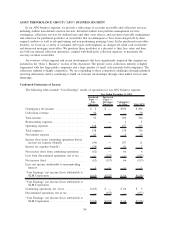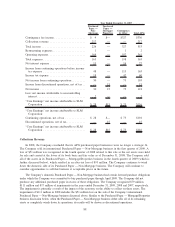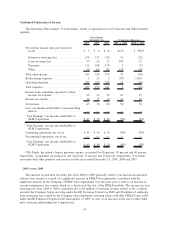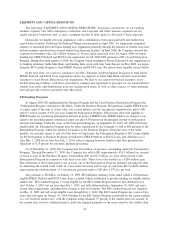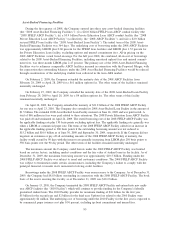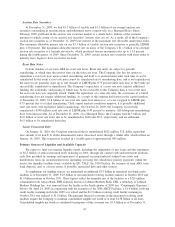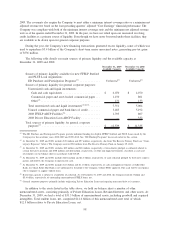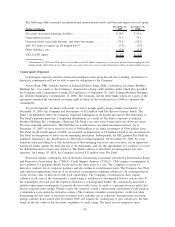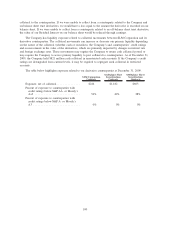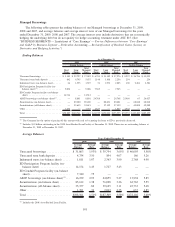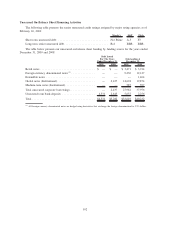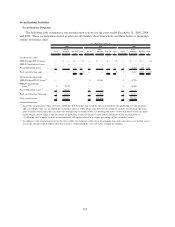Sallie Mae 2009 Annual Report Download - page 94
Download and view the complete annual report
Please find page 94 of the 2009 Sallie Mae annual report below. You can navigate through the pages in the report by either clicking on the pages listed below, or by using the keyword search tool below to find specific information within the annual report.LIQUIDITY AND CAPITAL RESOURCES
The following “LIQUIDITY AND CAPITAL RESOURCES” discussion concentrates on our Lending
business segment. Our APG contingency collections and Corporate and Other business segments are not
capital intensive businesses and, as such, a minimal amount of debt capital is allocated to these segments.
Historically, we funded new loan originations with a combination of term unsecured debt and student loan
asset-backed securities. Following the Proposed Merger announcement in April 2007, we temporarily suspended
issuance of unsecured debt and began funding loan originations primarily through the issuance of student loan asset-
backed securities and short-term secured student loan financing facilities. In June 2008, the Company accessed the
corporate bond market with a $2.5 billion issuance of 10-year senior unsecured notes. In August 2008, we began
funding new FFELP Stafford and PLUS Loan originations for AY 2008-2009 pursuant to ED’s Loan Participation
Program. During the fourth quarter of 2008, the Company began retaining its Private Education Loan originations in
its banking subsidiary, Sallie Mae Bank, and funding these assets with term bank deposits. In May 2009, we began
using the ED Conduit Program to fund FFELP Stafford and PLUS Loans. We discuss these liquidity sources below.
In the near term, we expect to continue to use ED’s Purchase and Participation Programs to fund future
FFELP Stafford and PLUS Loan originations and to use deposits at Sallie Mae Bank and term asset-backed
securities to fund Private Education Loan originations. We plan to use term asset-backed securities, asset-
backed financing facilities, cash flows provided by earnings and repayment of principal on our unencumbered
student loan assets and distributions from our securitization trusts, as well as other sources, to retire maturing
debt and provide cash for operations and other needs.
ED Funding Programs
In August 2008, ED implemented the Purchase Program and the Loan Purchase Participation Program (the
“Participation Program”) pursuant to ECASLA. Under the Purchase Program, ED purchases eligible FFELP loans
at a price equal to the sum of (i) par value, (ii) accrued interest, (iii) the one-percent origination fee paid to ED,
and (iv) a fixed amount of $75 per loan. Under the Participation Program, ED provides short-term liquidity to
FFELP lenders by purchasing participation interests in pools of FFELP loans. FFELP lenders are charged a rate
equal to the preceding quarter commercial paper rate plus 0.50 percent on the principal amount of participation
interests outstanding. Under the terms of the Participation Program, on September 30, 2010, AY 2009-2010 loans
funded under the Participation Program must be either repurchased by the Company or sold to ED pursuant to the
Participation Program, which has identical economics to the Purchase Program. Given the state of the credit
markets, we currently expect to sell all of the loans we fund under the Participation Program to ED. Loans eligible
for the Participation or Purchase Programs are limited to FFELP Stafford or PLUS Loans, first disbursed on or
after May 1, 2008 but no later than July 1, 2010, with no ongoing borrower benefits other than permitted rate
reductions of 0.25 percent for automatic payment processing.
As of December 31, 2009, the Company had $9.0 billion of advances outstanding under the Participation
Program. Through December 31, 2009, the Company has sold to ED approximately $18.5 billion face amount
of loans as part of the Purchase Program. Outstanding debt of $18.5 billion was paid down related to the
Participation Program in connection with these loan sales. These loan sales resulted in a $284 million gain.
The settlement of the fourth quarter sale of loans out of the Participation Program included repaying the debt
by delivering the related loans to ED in a non-cash transaction and receipt of cash from ED for $484 million,
representing the reimbursement of a one-percent payment made to ED plus a $75 fee per loan.
Also pursuant to ECASLA, on January 15, 2009, ED published summary terms under which it will purchase
eligible FFELP Stafford and PLUS Loans from a conduit vehicle established to provide funding for eligible student
lenders (the “ED Conduit Program”). Loans eligible for the ED Conduit Program must be first disbursed on or
after October 1, 2003, but not later than July 1, 2009, and fully disbursed before September 30, 2009, and meet
certain other requirements, including those relating to borrower benefits. The ED Conduit Program was launched
on May 11, 2009 and will accept eligible loans through July 1, 2010. The ED Conduit Program has a term of five
years and will expire on January 19, 2014. Funding for the ED Conduit Program is provided by the capital markets
at a cost based on market rates, with the Company being advanced 97 percent of the student loan face amount. If
the conduit does not have sufficient funds to make the required payments on the notes issued by the conduit, then
93





